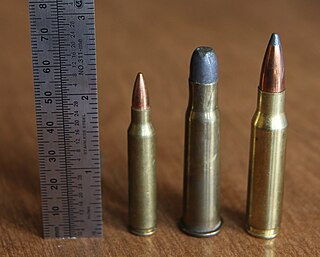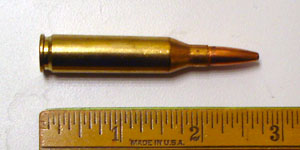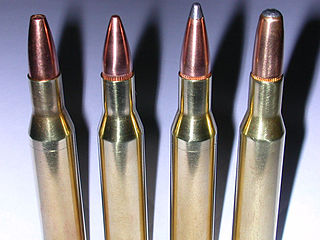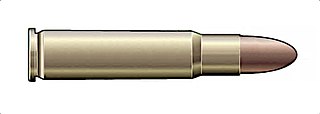 W
WThe .50 Browning Machine Gun is a .50 in (12.7 mm) caliber cartridge developed for the M2 Browning machine gun in the late 1910s, entering official service in 1921. Under STANAG 4383, it is a standard service cartridge for NATO forces as well as many non-NATO countries. The cartridge itself has been made in many variants: multiple generations of regular ball, tracer, armor-piercing (AP), incendiary, and saboted sub-caliber rounds. The rounds intended for machine guns are made into a continuous belt using metallic links.
 W
WThe .218 Bee is a .22 caliber centerfire rifle cartridge designed for varmint hunting by Winchester in 1937. The cartridge was originally chambered in the Winchester Model 65 lever-action rifles, which may have ultimately led to its lack of popularity. The cartridge is named for the bore diameter of the barrel in which the cartridge is chambered rather than the usual practice in the United States of having the cartridge's nomenclature reflect in some way the bullet diameter.
 W
WThe .220 Swift (5.56×56mmSR) is a semi-rimmed rifle cartridge developed by Winchester and introduced in 1935 for small game and vermin hunting. It was the first factory-loaded rifle cartridge with a muzzle velocity of over 1,200 m/s (4,000 ft/s), just over Mach 4.
 W
WThe 9×23mm Winchester is a pistol cartridge developed as a joint venture by Winchester Ammunition and Colt's Manufacturing Company. The 9×23mm Winchester has a convoluted development history, but was commercially introduced by Winchester in 1996. Marketed primarily to competition shooters as a replacement for .38 Super for International Practical Shooting Confederation, United States Practical Shooting Association and International Defensive Pistol Association competition, the cartridge failed to find significant market success despite a high-profile introduction.
 W
WThe .22 Hornet or 5.6×35mmR is a varminting, small-game hunting, survival and competition centerfire rifle cartridge commercially introduced in 1930. It is considerably more powerful than the rimfire .22 WMR and the .17 HMR, achieving higher velocity with a bullet twice the weight of the .17 HMR bullet. The Hornet also differs very significantly from these in that being a centerfire cartridge makes it reloadable, and thus much more versatile. It was the smallest commercially available .22 caliber centerfire cartridge until the introduction of the FN 5.7×28mm.
 W
WThe .22 Winchester Automatic is a .22 in (5.6 mm) American rimfire rifle cartridge.
 W
WThe .22 Winchester Rimfire is an American rimfire rifle cartridge.
 W
WThe .25-20 Winchester, or WCF, was developed around 1895 for the Winchester Model 1892 lever action rifle. It was based on necking down the .32-20 Winchester. In the early 20th century, it was a popular small game and varmint round, developing around 1,460 ft/s with 86-grain bullets. But two years earlier Marlin Firearms Co. had already necked down the .32-20 Winchester, and called it the .25-20 Marlin. It was first chambered in Model 1889 lever action Marlins long before Winchester did the same thing and put their name on the .25-20.
 W
WThe .25-35 Winchester, or WCF was introduced in 1895 by Winchester for the Winchester Model 1894 and Savage Model 99 lever action rifles. The case was based on the .30-30 cartridge.
 W
WThe .30 Carbine (7.62×33mm) is a rimless carbine/rifle cartridge used in the M1 carbine introduced in the 1940s. It is a light rifle round designed to be fired from the M1 carbine's 18-inch (458 mm) barrel.
 W
WThe .30-30 Winchester/.30 Winchester Center Fire cartridge was first marketed in 1895 for the Winchester Model 1894 lever-action rifle. The .30-30 (thirty-thirty), as it is most commonly known, and the .25-35 were offered that year as the USA's first small-bore sporting rifle cartridges designed for smokeless powder. Sixty years after its introduction, in 1955, it was surpassed by the smaller bore .243 Winchester cartridge with more powerful and accurate ballistics yet similar recoil, but the .30-.30 Winchester remains in widespread use even today.
 W
WThe .32 Winchester Special is a rimmed cartridge created in October 1901 for use in the Winchester Model 94 lever-action rifle. It is similar in name but unrelated to the .32-20 Winchester cartridge.
 W
WThe .32-20 Winchester, also known as .32 WCF , was the first small-game lever-action cartridge that Winchester produced. It was initially introduced as a black-powder cartridge in 1882 for small-game, varmint hunting, and deer. Colt produced a single-action revolver chambered for this cartridge a few years later.
 W
WThe .33 Winchester Center Fire is an American centerfire rifle cartridge.
 W
WThe .35 Winchester Self-Loading is an American rifle cartridge.
 W
WThe .38-40 Winchester is actually a .40" caliber (10 mm) cartridge shooting .401" (10.2 mm) caliber bullets. The cartridge was introduced by Winchester in 1874 and is derived from their .44-40 Winchester. This cartridge was introduced for rifles, but in its reintroduction for Cowboy Action Shooting it has seen some popularity as a revolver cartridge. It is not particularly well suited to hunting larger game, but it was popular when it was introduced, along with the previous .44-40 Winchester, for deer hunting. It can be used successfully on smaller game animals, and for self-defense. Current loadings are intended for revolvers.
 W
WThe .38-55 Winchester cartridge was introduced in 1876 by Ballard. It was used by Marlin Firearms from 1875 on for various single-shot target rifles and their 1893 lever action rifle. It was later offered by Winchester in its Model 1894. Winchester continued to use the round in various rifles until about 1940, and also used it in a few commemorative editions of rifles since then. In addition, Marlin offered it in some 336s, and it was used in non-lever action rifles such as the Remington-Lee bolt-action.
 W
WThe .38-56 Winchester Center Fire cartridge was introduced in 1887 by Winchester for the Winchester Model 1886, and was also used in the Marlin Model of 1895.
 W
WThe .40 S&W is a rimless pistol cartridge developed jointly by major American firearms manufacturers Smith & Wesson and Winchester. The .40 S&W was developed from the ground up as a law enforcement cartridge designed to duplicate performance of the Federal Bureau of Investigation's (FBI) reduced-velocity 10mm Auto cartridge which could be retrofitted into medium-frame semi-automatic handguns. It uses 0.40-inch (10 mm) diameter bullets ranging in weight from 105 to 200 grains.
 W
WThe .40-60 Winchester is a rimmed, tapered centerfire rifle cartridge designed for use in lever action rifles by Winchester Repeating Arms Company in 1884.
 W
WThe .40-72 Winchester, also known as .40-72 WCF is a centerfire straight-walled rifle cartridge designed for black powder rather than smokeless powder. It was introduced in 1895 for the Winchester 1895 lever-action rifle.
 W
WThe .44 Henry, also known as the .44 Rimfire, the .44 Long Rimfire, or the 11x23mmR in Europe, is a rimfire rifle and handgun cartridge featuring a .875 in (22.2 mm)-long brass or copper case. The round has a total overall length of 1.345 in (34.2 mm), with a 200 or 216 gr .446 in (11.3 mm)-diameter cast solid-lead heeled bullet. The original propellant load is 26 to 28 gr of black powder. The round has a muzzle velocity of approximately 1,125 ft/s (343 m/s), giving a muzzle energy of 568 foot-pounds.
 W
WThe .44-40 Winchester, also known as .44 Winchester, .44 WCF, and .44 Largo was introduced in 1873 by the Winchester Repeating Arms Company. It was the first metallic centerfire cartridge manufactured by Winchester, and was promoted as the standard chambering for the new Winchester Model 1873 rifle. As both a rifle and a handgun caliber, the cartridge soon became widely popular, so much so that the Winchester Model 1873 rifle became known as "The gun that won the West."
 W
WThe .45 Winchester Magnum is a .45 caliber rimless cartridge intended for use in semi-automatic pistols. The cartridge is externally a lengthened .45 ACP with a thicker web to withstand higher operating pressures. The 45 Win Mag is nearly identical in dimensions and loading to the .45 NAACO developed by the North American Arms Corporation for their Brigadier pistol, developed to supply to the Canadian Army after World War II. The army ultimately did not adopt the pistol and its non-NATO standard ammunition.
 W
WThe .45-60 Winchester is a centerfire rifle cartridge intended for 19th-century big-game hunting. Nomenclature of the era indicated the .45-60 cartridge contained a 0.45-inch (11.43 mm) diameter bullet with 60 grains (3.89 g) of black powder. Winchester Repeating Arms Company shortened the .45-70 government cartridge to operate through the Winchester Model 1876 rifle's lever-action.
 W
WThe .219 Zipper cartridge was created by Winchester Repeating Arms in 1937 to be used in their lever-action Model 64 rifle. It is a 30-30 Winchester cartridge necked down to a .22 caliber bullet. Marlin Firearms also offered their Marlin Model 336 rifle chambered for the cartridge.
 W
WThe .225 Winchester cartridge was introduced in 1964 by the Winchester Repeating Arms Company.
 W
WThe .243 Winchester (6.2×52mm) is a popular sporting rifle cartridge. Developed as a versatile short action cartridge to hunt both medium game and small game alike, it "took whitetail hunting by storm" when introduced in 1955, and remains one of the most popular whitetail deer cartridges. It is also commonly used for harvesting blacktail deer, pronghorns and mule deer with heavier rounds, and is equally suited to varmint hunting with lighter rounds. The .243 is based on a necked down .308 Winchester, introduced only three years earlier. Expanding monolithic copper bullets of approximately 80 to 85 grains or traditional lead rounds of 90 to 105 grains with controlled expansion designs are best suited for hunting medium game, while lighter rounds are intended for varmints.
 W
WThe .270 Winchester is a rifle cartridge developed by Winchester Repeating Arms Company in 1923 and unveiled in 1925 as a chambering for their bolt-action Model 54. The cartridge is the same length as the .280 Remington, both of which are longer than the .30-06 Springfield. The .270, .280, and .30-06 were all derived from the .30-03 parent case that came from the German 8x57 Mauser case which itself was based on the earlier 7x57 Mauser case. The .270 Winchester uses a .270 inch (6.86 mm) bore diameter and a .277 inch (7.04 mm) bullet diameter.
 W
WThe .284 Winchester is a cartridge that has enjoyed a resurgence due to interest from long-range competitive shooters. Winchester has continued to produce brass cases for this since 1963, Introduced by Winchester in 1963, the .284 Winchester was designed to achieve .270 Winchester and .280 Remington performance from the new Winchester Model 100 autoloader and Winchester Model 88 lever-action rifles.
 W
WThe .307 Winchester cartridge was introduced by Winchester in 1982 to meet the demand of .300 Savage performance in a lever-action rifle equipped with a tubular magazine. It is nearly dimensionally identical to the more common .308 Winchester cartridge, the only differences being a rimmed base and thicker case walls.
 W
WThe .308 Winchester is a smokeless powder rimless bottlenecked rifle cartridge.
 W
WThe .348 Winchester is an American rifle cartridge. It was introduced in 1936, and developed for the Winchester Model 71 lever action rifle. The .348 was one of the most powerful rimmed rounds ever used in a lever action rifle.
 W
WThe .351 Winchester Self-Loading is an American rifle cartridge designed in 1906.
 W
WThe .356 Winchester is a semi-rimmed, bottle-necked, centerfire rifle cartridge which was designed for use in lever-action rifles. It was developed concurrently with the .307 Winchester which acted as the parent cartridge. Both cartridges were introduced in 1982 in the then-new Model 94 XTR lever-action rifle.
 W
WThe .357 Smith & Wesson Magnum, .357 S&W Magnum, .357 Magnum, or 9×33mmR as it is known in unofficial metric designation, is a smokeless powder cartridge with a .357-inch (9.07 mm) bullet diameter. It was created by Elmer Keith, Phillip B. Sharpe, and Douglas B. Wesson of firearm manufacturers Smith & Wesson and Winchester.
 W
WThe .358 Winchester is a .35 caliber rifle cartridge based on a necked up .308 Winchester created by Winchester in 1955. The cartridge is also known in Europe as the 9.1x51mm.
 W
WThe .375 Winchester is a modernized version of the .38-55 Winchester, a black powder cartridge from 1884. It was introduced in 1978 along with the Winchester Model 94 “Big Bore” lever action rifle.
 W
WThe .401 Winchester Self-Loading is an American rifle cartridge.